Palace of Westminster: Difference between revisions
| (One intermediate revision by one other user not shown) | |||
| Line 22: | Line 22: | ||
The first royal palace was built on the site in the eleventh century, and Westminster was the primary residence of the Kings of England until a fire destroyed much of the complex in 1512. After that, it served as the home of the Parliament of England, which had been meeting there since the thirteenth century, and also as the seat of the Royal Courts of Justice, based in and around [[#Westminster Hall|Westminster Hall]]. In 1834, an even greater fire ravaged the heavily rebuilt Houses of Parliament, and the only mediæval structures of significance to survive were Westminster Hall, the Cloisters of St Stephen's, the Chapel of St Mary Undercroft, and the [[Jewel Tower]]. | The first royal palace was built on the site in the eleventh century, and Westminster was the primary residence of the Kings of England until a fire destroyed much of the complex in 1512. After that, it served as the home of the Parliament of England, which had been meeting there since the thirteenth century, and also as the seat of the Royal Courts of Justice, based in and around [[#Westminster Hall|Westminster Hall]]. In 1834, an even greater fire ravaged the heavily rebuilt Houses of Parliament, and the only mediæval structures of significance to survive were Westminster Hall, the Cloisters of St Stephen's, the Chapel of St Mary Undercroft, and the [[Jewel Tower]]. | ||
The subsequent competition for the reconstruction of the Palace was won by the architect Charles Barry, whose design was for new buildings in the Gothic Revival style, specifically inspired by the native Perpendicular Gothic style of the 14th-16th centuries. The remains of the Old Palace (with the exception of the detached Jewel Tower) were incorporated into its much larger replacement, which contains over 1,100 rooms organised symmetrically around two series of courtyards. Part of the New Palace's area of | The subsequent competition for the reconstruction of the Palace was won by the architect Charles Barry, whose design was for new buildings in the Gothic Revival style, specifically inspired by the native Perpendicular Gothic style of the 14th-16th centuries. The remains of the Old Palace (with the exception of the detached Jewel Tower) were incorporated into its much larger replacement, which contains over 1,100 rooms organised symmetrically around two series of courtyards. Part of the New Palace's area of eight acres was reclaimed from the Thames, which is the setting of its principal 290-yd façade, called the River Front. Barry was assisted by Augustus W N Pugin, a leading authority on Gothic architecture and style, who provided designs for the decorations and furnishings of the Palace. Construction started in 1840 and lasted for thirty years, suffering great delays and cost overruns, as well as the death of both leading architects; works for the interior decoration continued intermittently well into the twentieth century. Major conservation work has been carried out since, to reverse the effects of London's air pollution, and extensive repairs took place after the Second World War, including the reconstruction of the Commons Chamber following its bombing in 1941. | ||
The Palace is one of the centres of political life in the United Kingdom; "Westminster" has become a metonym for Parliament itself, and the Westminster system of government has taken its name after it. The Elizabeth Tower, in particular, which is often referred to by the name of its main bell, "Big Ben", is an iconic landmark of London and the United Kingdom in general, one of the most popular tourist attractions in the city and an emblem of parliamentary democracy. | The Palace is one of the centres of political life in the United Kingdom; "Westminster" has become a metonym for Parliament itself, and the Westminster system of government has taken its name after it. The Elizabeth Tower, in particular, which is often referred to by the name of its main bell, "Big Ben", is an iconic landmark of London and the United Kingdom in general, one of the most popular tourist attractions in the city and an emblem of parliamentary democracy. | ||
| Line 30: | Line 30: | ||
==History== | ==History== | ||
===Old Palace=== | ===Old Palace=== | ||
[[File:Westminster 16C.jpg|right|thumb|200px|Conjectural restoration of Westminster under Henry VIII (1884)]] | |||
[[File:Print of Houses of Parliament before 1834 Fire.jpg|right|thumb|200px|Parliament before 1834 Fire]] | [[File:Print of Houses of Parliament before 1834 Fire.jpg|right|thumb|200px|Parliament before 1834 Fire]] | ||
The Palace of Westminster site was strategically important during the Middle Ages, on the banks of the [[River Thames]] in an area anciently known as Thorney Island, between two branches of the | The Palace of Westminster site was strategically important during the Middle Ages, on the banks of the [[River Thames]] in an area anciently known as Thorney Island, between two branches of the River Tyburn and the Thames. The site may have been first-used for a royal residence by Canute the Great during his reign from 1016 to 1035. King Edward the Confessor, the penultimate Anglo-Saxon monarch of England, built a royal palace on Thorney Island just west of the [[City of London]] at about the same time as he built [[Westminster Abbey]] (1045–50). Thorney Island and the surrounding area soon became known as ''Westmynster'' from the latter. Neither the buildings used by the Anglo-Saxons nor those used by William I survive. The oldest existing part of the Palace (Westminster Hall) dates from the reign of William I's successor, King William II. | ||
The Palace of Westminster was the monarch's principal residence in the late Mediæval period. The predecessor of Parliament, the ''Curia Regis'' (Royal Council), met in Westminster Hall (although it followed the King when he moved to other palaces). Simon de Montfort's parliament, the first to include representatives of the major towns, met at the Palace in 1265. The "Model Parliament", the first official Parliament of England, met there in 1295,<ref name=FactsheetG03>{{cite web |url=http://www.parliament.uk/documents/commons-information-office/g03.pdf |title=A Brief Chronology of the House of Commons |date=April 2009 |format=PDF |publisher=House of Commons Information Office |accessdate=5 August 2010}}</ref> and almost all subsequent English Parliaments and then, after 1707, all British Parliaments have met at the Palace. | The Palace of Westminster was the monarch's principal residence in the late Mediæval period. The predecessor of Parliament, the ''Curia Regis'' (Royal Council), met in Westminster Hall (although it followed the King when he moved to other palaces). Simon de Montfort's parliament, the first to include representatives of the major towns, met at the Palace in 1265. The "Model Parliament", the first official Parliament of England, met there in 1295,<ref name=FactsheetG03>{{cite web |url=http://www.parliament.uk/documents/commons-information-office/g03.pdf |title=A Brief Chronology of the House of Commons |date=April 2009 |format=PDF |publisher=House of Commons Information Office |accessdate=5 August 2010}}</ref> and almost all subsequent English Parliaments and then, after 1707, all British Parliaments have met at the Palace. | ||
| Line 88: | Line 88: | ||
*The Central Tower | *The Central Tower | ||
The '''Victoria Tower''' is the tallest tower of the palace, standing at | The '''Victoria Tower''' is the tallest tower of the palace, standing at 323 feet<ref name=FactsheetG11>[http://www.parliament.uk/documents/commons-information-office/g11.pdf The Palace of Westminster] - House of Commons Information Office</ref> at the south-western corner of the Palace. It was an integral part of Barry's original design, conceived as the keep of a legislative "castle" (echoing his selection of the portcullis as his identifying mark in the planning competition), and used it as the royal entrance to the Palace and as a fireproof repository for the archives of Parliament.<ref>[[#Quinault|Quinault (1991)]], p. 81; [[#Jones|Jones (1983)]], p. 113.</ref> Victoria Tower was re-designed several times, and its height increased progressively;<ref>[[#Port|Port (1976)]], pp. 76, 109; [[#Riding|Riding and Riding (2000)]], p. 116.</ref> upon its completion in 1858, it was the tallest secular building in the world.<ref>[[#Quinault|Quinault (1991)]], p. 81.</ref> | ||
At the base of the tower is the Sovereign's Entrance, used by the monarch whenever entering the Palace to open Parliament or for other state occasions. The 50 ft high archway is richly decorated with sculptures, including statues of Saints George, Andrew and Patrick, as well as of Queen Victoria herself.<ref>#Fell|Fell and Mackenzie (1994), p. 30.</ref> The main body of Victoria Tower houses the three million documents of the Parliamentary Archives in over five miles of steel shelves spread over 12 floors; these include the master copies of all Acts of Parliament since 1497, and important manuscripts such as the original Bill of Rights of 1689 and the death warrant King Charles I.<ref>[[#Fell|Fell and Mackenzie (1994)]], p. 44.</ref> At the top of the cast-iron pyramidal roof is a 22 m (73 ft)<ref name=FactsheetG11/> flagstaff, from which flies the Royal Standard (the monarch's personal flag) when the Sovereign is present in the Palace. On all other days the [[Union Flag]] flies from the mast.<ref>{{cite web |url=http://edmi.parliament.uk/EDMi/EDMDetails.aspx?EDMID=40851 |title=Early Day Motions – EDM 1199: Union Flag at Parliament |publisher=UK Parliament |date=29 March 2010 |accessdate=20 February 2010}}</ref> | At the base of the tower is the Sovereign's Entrance, used by the monarch whenever entering the Palace to open Parliament or for other state occasions. The 50 ft high archway is richly decorated with sculptures, including statues of Saints George, Andrew and Patrick, as well as of Queen Victoria herself.<ref>#Fell|Fell and Mackenzie (1994), p. 30.</ref> The main body of Victoria Tower houses the three million documents of the Parliamentary Archives in over five miles of steel shelves spread over 12 floors; these include the master copies of all Acts of Parliament since 1497, and important manuscripts such as the original Bill of Rights of 1689 and the death warrant King Charles I.<ref>[[#Fell|Fell and Mackenzie (1994)]], p. 44.</ref> At the top of the cast-iron pyramidal roof is a 22 m (73 ft)<ref name=FactsheetG11/> flagstaff, from which flies the Royal Standard (the monarch's personal flag) when the Sovereign is present in the Palace. On all other days the [[Union Flag]] flies from the mast.<ref>{{cite web |url=http://edmi.parliament.uk/EDMi/EDMDetails.aspx?EDMID=40851 |title=Early Day Motions – EDM 1199: Union Flag at Parliament |publisher=UK Parliament |date=29 March 2010 |accessdate=20 February 2010}}</ref> | ||
[[File:Big Ben 2007-1.jpg|right|thumb|200px|The Elizabeth Tower]] | [[File:Big Ben 2007-1.jpg|right|thumb|200px|The Elizabeth Tower]] | ||
The '''Elizabeth Tower''' is the most famous of the towers. It houses the Great Clock and is commonly known as 'Big Ben' which technically is the name of the great bell in the tower which tolls the hour. It was known as "the Clock Tower" untl 2012, when it was renamed to honour the Diamond Jubilee of Queen Elizabeth II. At 316 feet, the Elizabeth Tower it is only slightly shorter than Victoria Tower but much slimmer.<ref name=FactsheetG11/> It houses the Great Clock of Westminster, built by Edward John Dent on designs by amateur horologist Edmund Beckett Denison.<ref>{{cite web|url=http://www.parliament.uk/about/living-heritage/building/palace/big-ben/building-clock-tower/building-great-clock|title=Building the Great Clock|publisher=UK Parliament|accessdate=14 May 2010}}</ref> Striking the hour to within a second of the time, the Great Clock achieved standards of accuracy considered impossible by 19th-century clockmakers, and it has remained consistently reliable since it entered service in 1859.<ref>[[#Macdonald|Macdonald (2004)]], pp. xiii–xiv.</ref> The time is shown on four dials | The '''Elizabeth Tower''' is the most famous of the towers. It houses the Great Clock and is commonly known as 'Big Ben' which technically is the name of the great bell in the tower which tolls the hour. It was known as "the Clock Tower" untl 2012, when it was renamed to honour the Diamond Jubilee of Queen Elizabeth II. At 316 feet, the Elizabeth Tower it is only slightly shorter than Victoria Tower but much slimmer.<ref name=FactsheetG11/> It houses the Great Clock of Westminster, built by Edward John Dent on designs by amateur horologist Edmund Beckett Denison.<ref>{{cite web|url=http://www.parliament.uk/about/living-heritage/building/palace/big-ben/building-clock-tower/building-great-clock|title=Building the Great Clock|publisher=UK Parliament|accessdate=14 May 2010}}</ref> Striking the hour to within a second of the time, the Great Clock achieved standards of accuracy considered impossible by 19th-century clockmakers, and it has remained consistently reliable since it entered service in 1859.<ref>[[#Macdonald|Macdonald (2004)]], pp. xiii–xiv.</ref> The time is shown on four dials 23 ft in diameter, which are made of milk glass and are lit from behind at night; the hour hand is nine feet long and the minute hand 14 feet.<ref>{{cite web|url=http://www.parliament.uk/about/living-heritage/building/palace/big-ben/facts-figures/great-clock-facts|title=Great Clock facts|publisher=UK Parliament|accessdate=14 May 2010}}</ref> The Clock Tower was designed by Augustus Pugin and built after his death. Charles Barry asked Pugin to design the clock tower because Pugin had previously helped Barry design the Palace<ref>BBC Four Pugin: God's Own Architect presented by Richard Taylor 2012</ref> In the 2012 BBC Four documentary, Richard Taylor gives a description of Pugin's Clock Tower: "It rises up from the ground in this stately rhythm, higher and higher, before you reach the clock face, picked out as a giant rose, its petals fringed with gold. Mediæval windows above that and then it hits the grey slate roof, its greyness relieved by those delicate little windows again picked out in gold leaf. And then rises up again in a great jet of gold to the higher roof that curves gracefully upwards to a spire with a crown and flowers and a cross. It's elegant and grand and has fairy tale qualities." | ||
Five bells hang in the belfry above the clock. The four quarter bells strike the 'Westminster Chimes' (copied from those of [[King's College Chapel]] in [[Cambridge]]) every quarter-hour.<ref>[[#Fell|Fell and Mackenzie (1994)]], pp. 24, 26.</ref> The largest bell strikes the hours; officially called ''The Great Bell of Westminster'', it is generally referred to as ''Big Ben'', a nickname of uncertain origins which, over time, has been colloquially applied to the whole tower. The first bell to bear this name cracked during testing and was recast;<ref>{{cite web|url=http://www.parliament.uk/about/living-heritage/building/palace/big-ben/building-clock-tower/great-bell|title=The Great Bell – Big Ben|publisher=UK Parliament|accessdate=14 May 2010}}</ref> the present bell later developed a crack of its own, which gives it a distinctive sound.<ref>[[#Macdonald|Macdonald (2004)]], pp. xvi–xvii, 50.</ref> It is the third-heaviest bell in Britain, weighing 13.8 tonnes.<ref>{{cite web|url=http://www.parliament.uk/about/living-heritage/building/palace/big-ben/facts-figures/great-bell|title=The Great Bell and the quarter bells|publisher=UK Parliament|accessdate=14 May 2010}}</ref><ref>[[#Macdonald|Macdonald (2004)]], p. 174.</ref> In the lantern at the top of Elizabeth Tower is the Ayrton Light, which is lit when either House of Parliament is sitting after dark. It was installed in 1885 at the request of Queen Victoria—so that she could see from [[Buckingham Palace]] whether the members were "at work"—and named after Acton Smee Ayrton, who was First Commissioner of Works in the 1870s.<ref>[[#Jones|Jones (1983)]], pp. 112–3.</ref><ref>{{cite web|url=http://www.parliament.uk/visiting/online-tours/virtualtours/bigben-tour|title=Elizabeth Tower virtual tour|publisher=UK Parliament|accessdate=15 May 2010}}</ref> | Five bells hang in the belfry above the clock. The four quarter bells strike the 'Westminster Chimes' (copied from those of [[King's College Chapel]] in [[Cambridge]]) every quarter-hour.<ref>[[#Fell|Fell and Mackenzie (1994)]], pp. 24, 26.</ref> The largest bell strikes the hours; officially called ''The Great Bell of Westminster'', it is generally referred to as ''Big Ben'', a nickname of uncertain origins which, over time, has been colloquially applied to the whole tower. The first bell to bear this name cracked during testing and was recast;<ref>{{cite web|url=http://www.parliament.uk/about/living-heritage/building/palace/big-ben/building-clock-tower/great-bell|title=The Great Bell – Big Ben|publisher=UK Parliament|accessdate=14 May 2010}}</ref> the present bell later developed a crack of its own, which gives it a distinctive sound.<ref>[[#Macdonald|Macdonald (2004)]], pp. xvi–xvii, 50.</ref> It is the third-heaviest bell in Britain, weighing 13.8 tonnes.<ref>{{cite web|url=http://www.parliament.uk/about/living-heritage/building/palace/big-ben/facts-figures/great-bell|title=The Great Bell and the quarter bells|publisher=UK Parliament|accessdate=14 May 2010}}</ref><ref>[[#Macdonald|Macdonald (2004)]], p. 174.</ref> In the lantern at the top of Elizabeth Tower is the Ayrton Light, which is lit when either House of Parliament is sitting after dark. It was installed in 1885 at the request of Queen Victoria—so that she could see from [[Buckingham Palace]] whether the members were "at work"—and named after Acton Smee Ayrton, who was First Commissioner of Works in the 1870s.<ref>[[#Jones|Jones (1983)]], pp. 112–3.</ref><ref>{{cite web|url=http://www.parliament.uk/visiting/online-tours/virtualtours/bigben-tour|title=Elizabeth Tower virtual tour|publisher=UK Parliament|accessdate=15 May 2010}}</ref> | ||
[[File:Central Tower, Palace of Westminster.jpg|right|thumb|200px|The slender form of the Central Tower]] | [[File:Central Tower, Palace of Westminster.jpg|right|thumb|200px|The slender form of the Central Tower]] | ||
The '''Central Tower''' is the shortest of the Palace's three principal towers (at | The '''Central Tower''' is the shortest of the Palace's three principal towers (at just under 300 ft)<ref name=FactsheetG11/>). It is octagonal in form and stands over the middle of the building, immediately above the Central Lobby. It was added to the plans on the insistence of Dr David Boswell Reid, who was in charge of the ventilation of the new Houses of Parliament: his plan called for a great central chimney through which what he called "vitiated air" would be drawn out of the building with the heat and smoke of about four hundred fires around the Palace.<ref>[[#Port|Port (1976)]], p. 221; [[#Jones|Jones (1983)]], p. 119.</ref> To accommodate the tower, Barry was forced to lower the lofty ceiling he had planned for the Central Lobby and reduce the height of its windows;<ref>[[#Jones|Jones (1983)]], pp. 108–109; [[#Field|Field (2002)]], p. 189.</ref> however, the tower itself proved to be an opportunity to improve the Palace's exterior design,<ref name="Riding, p. 120">[[#Riding|Riding and Riding (2000)]], p. 120.</ref> and Barry chose for it the form of a [[spire]] in order to balance the effect of the more massive lateral towers.<ref>[[#Port|Port (1976)]], p. 103.</ref> In the end, the Central Tower failed completely to fulfill its stated purpose, but it is notable as "the first occasion when mechanical services had a real influence on architectural design".<ref>{{cite book |last=Collins |first=Peter |title=Changing Ideals in Modern Architecture 1750–1950 |edition=1st |year=1965 |publisher=McGill-Queen's University Press |location=Montreal, Quebec; Kingston, Ontario |page=238 |isbn=978-0773500488}} cited in [[#Port|Port (1976)]], p. 206.</ref> | ||
Apart from the pinnacles which rise from between the window bays along the fronts of the Palace, numerous turrets enliven the building's skyline. Like the Central Tower, these have been added for practical reasons, and mask ventilation shafts.<ref name="Riding, p. 120"/> | Apart from the pinnacles which rise from between the window bays along the fronts of the Palace, numerous turrets enliven the building's skyline. Like the Central Tower, these have been added for practical reasons, and mask ventilation shafts.<ref name="Riding, p. 120"/> | ||
| Line 107: | Line 107: | ||
==Interior== | ==Interior== | ||
The Palace of Westminster contains over 1,100 rooms, 100 staircases and | The Palace of Westminster contains over 1,100 rooms, 100 staircases and three miles of passageways,<ref name=FactsheetG11/> which are spread over four floors. The ground floor is occupied by offices, dining rooms and bars; the first floor (known as the ''principal floor'') houses the main rooms of the Palace, including the debating chambers, the lobbies and the libraries. The top-two floors are used as committee rooms and offices. | ||
Some of the interiors were designed and painted by J.G. Crace, working in collaboration with Pugin and others. For example, Crace decorated and gilded the ceiling of the Chapel of St. Mary Undercroft.<ref>[http://www.parliament.uk/worksofart/artwork/edward-m-barry/houses-of-parliament-st-stephen%27s-crypt-restored--about-1863-/1601 Art in Parliament]: ''Houses of Parliament, St Stephen's Crypt (Restored)''.</ref> | Some of the interiors were designed and painted by J.G. Crace, working in collaboration with Pugin and others. For example, Crace decorated and gilded the ceiling of the Chapel of St. Mary Undercroft.<ref>[http://www.parliament.uk/worksofart/artwork/edward-m-barry/houses-of-parliament-st-stephen%27s-crypt-restored--about-1863-/1601 Art in Parliament]: ''Houses of Parliament, St Stephen's Crypt (Restored)''.</ref> | ||
| Line 115: | Line 115: | ||
Westminster Hall, the oldest existing part of the Palace of Westminster, was erected in 1097, at which point it was the largest hall in Europe. The roof was probably originally supported by pillars, giving three aisles, but during the reign of King Richard II, this was replaced by a hammerbeam roof by the royal carpenter Hugh Herland, "the greatest creation of mediæval timber architecture", which allowed the original three aisles to be replaced with a single huge open space, with a dais at the end. The new roof was commissioned in 1393.<ref>{{cite web |url=http://www.parliament.uk/about/living-heritage/building/palace/westminsterhall/architecture/the-hammer-beam-roof-/ |title=The hammer-beam roof |publisher=UK Parliament |accessdate=28 May 2011}}</ref> Richard's architect [[Henry Yevele]] left the original dimensions, refacing the walls, with fifteen life-size statues of kings placed in niches.<ref>Jonathan Alexander & Paul Binski (eds), ''Age of Chivalry, Art in Plantagenet England, 1200–1400'', pp. 506–507, Royal Academy/Weidenfeld & Nicholson, London 1987. Only six of the statues, rather damaged, remain, and the dias has been remodelled, but otherwise the hall remains largely as Richard and his architect Henry Yevele left it.</ref> The rebuilding had been begun by [[Henry III of England|King Henry III]] in 1245, but had by Richard's time been dormant for over a century. In Westminster Hall, the favourite heraldic badge of Richard II, a white hart, chained, and in an attitude of rest, is repeated as many as eighty-three times, without any of them being an exact counterpart of another.<ref>Charles Boutell, ''The Handbook to English Heraldry'' 11th ed., rev. A. C. Fox-Davies (London: Reeves & Turner, 1914), p. 28</ref> | Westminster Hall, the oldest existing part of the Palace of Westminster, was erected in 1097, at which point it was the largest hall in Europe. The roof was probably originally supported by pillars, giving three aisles, but during the reign of King Richard II, this was replaced by a hammerbeam roof by the royal carpenter Hugh Herland, "the greatest creation of mediæval timber architecture", which allowed the original three aisles to be replaced with a single huge open space, with a dais at the end. The new roof was commissioned in 1393.<ref>{{cite web |url=http://www.parliament.uk/about/living-heritage/building/palace/westminsterhall/architecture/the-hammer-beam-roof-/ |title=The hammer-beam roof |publisher=UK Parliament |accessdate=28 May 2011}}</ref> Richard's architect [[Henry Yevele]] left the original dimensions, refacing the walls, with fifteen life-size statues of kings placed in niches.<ref>Jonathan Alexander & Paul Binski (eds), ''Age of Chivalry, Art in Plantagenet England, 1200–1400'', pp. 506–507, Royal Academy/Weidenfeld & Nicholson, London 1987. Only six of the statues, rather damaged, remain, and the dias has been remodelled, but otherwise the hall remains largely as Richard and his architect Henry Yevele left it.</ref> The rebuilding had been begun by [[Henry III of England|King Henry III]] in 1245, but had by Richard's time been dormant for over a century. In Westminster Hall, the favourite heraldic badge of Richard II, a white hart, chained, and in an attitude of rest, is repeated as many as eighty-three times, without any of them being an exact counterpart of another.<ref>Charles Boutell, ''The Handbook to English Heraldry'' 11th ed., rev. A. C. Fox-Davies (London: Reeves & Turner, 1914), p. 28</ref> | ||
Westminster Hall has the largest clearspan mediæval roof in England, measuring | Westminster Hall has the largest clearspan mediæval roof in England, measuring 68 feet by 240 feet.<ref name=FactsheetG11/> Oak timbers for the roof came from royal woods in Hampshire and from parks in Hertfordshire and from that of William Crozier of [[Stoke D'Abernon]], who supplied over 600 oaks in Surrey, among other sources; they were assembled near [[Farnham]], Surrey.<ref>[[#Gerhold|Gerhold (1999)]], pp. 19–20.</ref> Accounts record the large number of wagons and barges which delivered the jointed timbers to Westminster for assembly.<ref>{{Cite book |last=Salzman |first=L. F. |authorlink=Louis Francis Salzman |title=Building in England down to 1540: A Documentary History |year=1992 |origyear=1952 |publisher=Oxford University Press, USA |isbn=978-0198171584 |oclc=758400852}}</ref> | ||
Westminster Hall has served numerous functions. It was primarily used for judicial purposes, housing three of the most important courts in the land: the Court of King's Bench, the Court of Common Pleas and the Court of Chancery. In 1875, these courts were amalgamated into the High Court of Justice, which continued to meet in Westminster Hall until it moved to the Royal Courts of Justice in 1882.<ref>{{cite web |url=http://www.hmcourts-service.gov.uk/infoabout/rcj/history.htm |title=Royal Courts of Justice visitors guide |publisher=Her Majesty's Courts Service |accessdate=16 May 2010 |archiveurl=http://web.archive.org/web/20100724214206/http://www.hmcourts-service.gov.uk/infoabout/rcj/history.htm |archivedate=24 July 2011 |deadurl=yes}}</ref> In addition to regular courts, Westminster Hall also housed important trials, including impeachment trials and the state trials of King Charles I at the end of the Civil War, William Wallace, Thomas More, Cardinal John Fisher, Guy Fawkes, the Earl of Strafford, the rebel Scottish lords of the 1715 and 1745 uprisings, and Warren Hastings. The St Stephen's Porch end of the Hall displays under the stained glass windows the Parliamentary War Memorial listing on eight panels the names of Members and staff of both Houses Parliament and their sons killed serving in the First World War; the window itself commemorates members and staff of both Houses who died in the Second World War. | Westminster Hall has served numerous functions. It was primarily used for judicial purposes, housing three of the most important courts in the land: the Court of King's Bench, the Court of Common Pleas and the Court of Chancery. In 1875, these courts were amalgamated into the High Court of Justice, which continued to meet in Westminster Hall until it moved to the Royal Courts of Justice in 1882.<ref>{{cite web |url=http://www.hmcourts-service.gov.uk/infoabout/rcj/history.htm |title=Royal Courts of Justice visitors guide |publisher=Her Majesty's Courts Service |accessdate=16 May 2010 |archiveurl=http://web.archive.org/web/20100724214206/http://www.hmcourts-service.gov.uk/infoabout/rcj/history.htm |archivedate=24 July 2011 |deadurl=yes}}</ref> In addition to regular courts, Westminster Hall also housed important trials, including impeachment trials and the state trials of King Charles I at the end of the Civil War, William Wallace, Thomas More, Cardinal John Fisher, Guy Fawkes, the Earl of Strafford, the rebel Scottish lords of the 1715 and 1745 uprisings, and Warren Hastings. The St Stephen's Porch end of the Hall displays under the stained glass windows the Parliamentary War Memorial listing on eight panels the names of Members and staff of both Houses Parliament and their sons killed serving in the First World War; the window itself commemorates members and staff of both Houses who died in the Second World War. | ||
[[File:George IV coronation banquet.jpg|left|thumb|200px||George IV's coronation banquet in Westminster Hall, 1821]] | [[File:George IV coronation banquet.jpg|left|thumb|200px||George IV's coronation banquet in Westminster Hall, 1821]] | ||
Westminster Hall has also served ceremonial functions. From the twelfth century to the nineteenth, coronation banquets honouring new monarchs were held here. The last coronation banquet was that of King George IV, held in 1821;<ref>{{cite web |url=http://www.parliament.uk/about/living-heritage/building/palace/westminsterhall/other-uses/coronation-banquets/ |title=Westminster Hall: Coronation Banquets |publisher=UK Parliament |accessdate=5 August 2010}}</ref> his successor, William IV, abandoned the idea because he deemed it too expensive. The Hall has been used for lyings-in-state during state and ceremonial funerals. Such an honour is usually reserved for the Sovereign and for their consorts; the only non-royals to receive it in the twentieth century were | Westminster Hall has also served ceremonial functions. From the twelfth century to the nineteenth, coronation banquets honouring new monarchs were held here. The last coronation banquet was that of King George IV, held in 1821;<ref>{{cite web |url=http://www.parliament.uk/about/living-heritage/building/palace/westminsterhall/other-uses/coronation-banquets/ |title=Westminster Hall: Coronation Banquets |publisher=UK Parliament |accessdate=5 August 2010}}</ref> his successor, William IV, abandoned the idea because he deemed it too expensive. The Hall has been used for lyings-in-state during state and ceremonial funerals. Such an honour is usually reserved for the Sovereign and for their consorts; the only non-royals to receive it in the twentieth century were Frederick Sleigh Roberts, 1st Earl Roberts (1914) and Winston Churchill (1965). The most recent lying-in-state was that of Queen Elizabeth The Queen Mother in 2002. | ||
It is considered a rare privilege for a foreign leader to be allowed to address both houses in Westminster Hall. Since the Second World War the only leaders to have done so have been French president Charles de Gaulle in 1960, South African president Nelson Mandela in 1996, Pope Benedict XVI in 2010, U.S. president Barack Obama in 2011 and Burmese opposition leader Aung San Suu Kyi in 2012.<ref>{{Cite news|url=http://news.yahoo.com/s/afp/20110522/wl_uk_afp/usobamadiplomacybritainroyals_20110522145524 |title=Queen to roll out red carpet for Obamas |publisher=AFP (via Yahoo News) |date=22 May 2011 |accessdate=25 May 2011 |deadurl=yes |archiveurl=https://web.archive.org/20110524065211/http://news.yahoo.com:80/s/afp/20110522/wl_uk_afp/usobamadiplomacybritainroyals_20110522145524 |archivedate=24 May 2011 }}</ref><ref name="BBCNews25May2011_9495513">{{Cite news |url=http://news.bbc.co.uk/democracylive/hi/house_of_commons/newsid_9495000/9495513.stm |title=US President Barack Obama addressing MPs and peers |publisher=BBC News |date=22 May 2011 |accessdate=25 May 2011 |archiveurl=http://www.webcitation.org/5ywktyOBN |archivedate=25 May 2011 |deadurl=no}}</ref><ref>{{cite news |title=Aung San Suu Kyi calls for UK's support over Burma |url=http://www.bbc.co.uk/news/uk-18529727 |publisher=BBC News |date=21 June 2012 |accessdate=24 June 2012}}</ref> President Obama was the first ever US President to be allowed to use the Hall for an address to Parliament<ref name="BBCNews25May2011_13533306">{{Cite news |url=http://www.bbc.co.uk/news/uk-politics-13533306 |title=President Obama: Now is time for US and West to lead |publisher=BBC News |date=22 May 2011 |accessdate=25 May 2011}}</ref> and Aung San Suu Kyi was the first non-head of state to be given the accolade of addressing MPs and peers in Westminster Hall. | It is considered a rare privilege for a foreign leader to be allowed to address both houses in Westminster Hall. Since the Second World War the only leaders to have done so have been French president Charles de Gaulle in 1960, South African president Nelson Mandela in 1996, Pope Benedict XVI in 2010, U.S. president Barack Obama in 2011 and Burmese opposition leader Aung San Suu Kyi in 2012.<ref>{{Cite news|url=http://news.yahoo.com/s/afp/20110522/wl_uk_afp/usobamadiplomacybritainroyals_20110522145524 |title=Queen to roll out red carpet for Obamas |publisher=AFP (via Yahoo News) |date=22 May 2011 |accessdate=25 May 2011 |deadurl=yes |archiveurl=https://web.archive.org/20110524065211/http://news.yahoo.com:80/s/afp/20110522/wl_uk_afp/usobamadiplomacybritainroyals_20110522145524 |archivedate=24 May 2011 }}</ref><ref name="BBCNews25May2011_9495513">{{Cite news |url=http://news.bbc.co.uk/democracylive/hi/house_of_commons/newsid_9495000/9495513.stm |title=US President Barack Obama addressing MPs and peers |publisher=BBC News |date=22 May 2011 |accessdate=25 May 2011 |archiveurl=http://www.webcitation.org/5ywktyOBN |archivedate=25 May 2011 |deadurl=no}}</ref><ref>{{cite news |title=Aung San Suu Kyi calls for UK's support over Burma |url=http://www.bbc.co.uk/news/uk-18529727 |publisher=BBC News |date=21 June 2012 |accessdate=24 June 2012}}</ref> President Obama was the first ever US President to be allowed to use the Hall for an address to Parliament<ref name="BBCNews25May2011_13533306">{{Cite news |url=http://www.bbc.co.uk/news/uk-politics-13533306 |title=President Obama: Now is time for US and West to lead |publisher=BBC News |date=22 May 2011 |accessdate=25 May 2011}}</ref> and Aung San Suu Kyi was the first non-head of state to be given the accolade of addressing MPs and peers in Westminster Hall. | ||
| Line 155: | Line 155: | ||
{{DEFAULTSORT:Palace Of Westminster}} | {{DEFAULTSORT:Palace Of Westminster}} | ||
[[Category:Parliament Square]] | |||
[[Category:Government buildings in Middlesex]] | [[Category:Government buildings in Middlesex]] | ||
[[Category: | [[Category:Clock towers in Middlesex]] | ||
[[Category:World Heritage Sites in the United Kingdom]] | [[Category:World Heritage Sites in the United Kingdom]] | ||
Latest revision as of 22:38, 26 December 2019
| Palace of Westminster | |
|
Middlesex | |
|---|---|
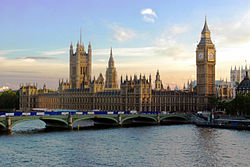 The Palace of Westminster from across the Thames | |
| Type: | Palace |
| Location | |
| Grid reference: | TQ30297949 |
| Location: | 51°29’58"N, 0°7’28"W |
| City: | Westminster |
| History | |
| Address: | Parliament Square, SW1A 0AA |
| Built 1840–70 | |
| By: | Charles Barry and Augustus Pugin |
| Palace | |
| Perpendicular Gothic revival | |
| Information | |
| Owned by: | The Crown |
The Palace of Westminster stands majestic on the Middlesex bank of the River Thames in the heart of Westminster, and it is around this place and the surrounding buildings of state that the City of Westminster grew. This is the meeting place of Parliament, both the House of Lords and the House of Commons, for which reason the Palace's popular name is "the Houses of Parliament".
The current palace is a Victorian Gothic edifice, but it stands where Kings and Parliaments have met since the eleventh century. In front of the Palace of Westminster is Parliament Square (which was laid out in 1868), around which stand Westminster Abbey and St Margaret's Church, the Treasury (and leading off from it the complex of buildings of Whitehall) and the Middlesex Guildhall.
The first royal palace was built on the site in the eleventh century, and Westminster was the primary residence of the Kings of England until a fire destroyed much of the complex in 1512. After that, it served as the home of the Parliament of England, which had been meeting there since the thirteenth century, and also as the seat of the Royal Courts of Justice, based in and around Westminster Hall. In 1834, an even greater fire ravaged the heavily rebuilt Houses of Parliament, and the only mediæval structures of significance to survive were Westminster Hall, the Cloisters of St Stephen's, the Chapel of St Mary Undercroft, and the Jewel Tower.
The subsequent competition for the reconstruction of the Palace was won by the architect Charles Barry, whose design was for new buildings in the Gothic Revival style, specifically inspired by the native Perpendicular Gothic style of the 14th-16th centuries. The remains of the Old Palace (with the exception of the detached Jewel Tower) were incorporated into its much larger replacement, which contains over 1,100 rooms organised symmetrically around two series of courtyards. Part of the New Palace's area of eight acres was reclaimed from the Thames, which is the setting of its principal 290-yd façade, called the River Front. Barry was assisted by Augustus W N Pugin, a leading authority on Gothic architecture and style, who provided designs for the decorations and furnishings of the Palace. Construction started in 1840 and lasted for thirty years, suffering great delays and cost overruns, as well as the death of both leading architects; works for the interior decoration continued intermittently well into the twentieth century. Major conservation work has been carried out since, to reverse the effects of London's air pollution, and extensive repairs took place after the Second World War, including the reconstruction of the Commons Chamber following its bombing in 1941.
The Palace is one of the centres of political life in the United Kingdom; "Westminster" has become a metonym for Parliament itself, and the Westminster system of government has taken its name after it. The Elizabeth Tower, in particular, which is often referred to by the name of its main bell, "Big Ben", is an iconic landmark of London and the United Kingdom in general, one of the most popular tourist attractions in the city and an emblem of parliamentary democracy.
The Palace of Westminster is part of a UNESCO World Heritage Site declared in 1987.[1]
History
Old Palace
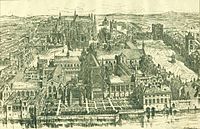
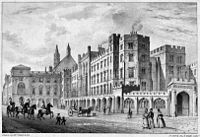
The Palace of Westminster site was strategically important during the Middle Ages, on the banks of the River Thames in an area anciently known as Thorney Island, between two branches of the River Tyburn and the Thames. The site may have been first-used for a royal residence by Canute the Great during his reign from 1016 to 1035. King Edward the Confessor, the penultimate Anglo-Saxon monarch of England, built a royal palace on Thorney Island just west of the City of London at about the same time as he built Westminster Abbey (1045–50). Thorney Island and the surrounding area soon became known as Westmynster from the latter. Neither the buildings used by the Anglo-Saxons nor those used by William I survive. The oldest existing part of the Palace (Westminster Hall) dates from the reign of William I's successor, King William II.
The Palace of Westminster was the monarch's principal residence in the late Mediæval period. The predecessor of Parliament, the Curia Regis (Royal Council), met in Westminster Hall (although it followed the King when he moved to other palaces). Simon de Montfort's parliament, the first to include representatives of the major towns, met at the Palace in 1265. The "Model Parliament", the first official Parliament of England, met there in 1295,[2] and almost all subsequent English Parliaments and then, after 1707, all British Parliaments have met at the Palace.
In 1512, during the early years of the reign of King Henry VIII, fire destroyed the royal residential ("privy") area of the palace.[3] In 1534, Henry VIII acquired York Place from Cardinal Thomas Wolsey,[4] a powerful minister who had lost the King's favour. Renaming it the Palace of Whitehall, Henry used it as his principal residence. Although Westminster officially remained a royal palace, it was used by the two Houses of Parliament and by the various royal law courts.
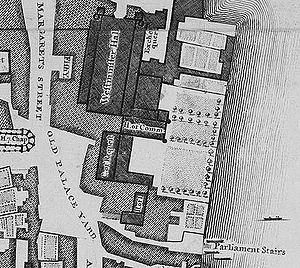
Because it was originally a royal residence, the Palace included no purpose-built chambers for the two Houses. Important state ceremonies were held in the Painted Chamber which had been originally built in the 13th century as the main bedchamber for King Henry III. The House of Lords originally met in the Queen's Chamber, a modest Mediæval hall towards the southern end of the complex, with the adjoining Prince's Chamber used as the robing room for peers and for the monarch during state openings. In 1801 the Upper House moved into the larger White Chamber (also known as the Lesser Hall), which had housed the Court of Requests. The expansion of the Peerage by King George III during the 18th century, along with the imminent Act of Union with Ireland, necessitated the move, as the original chamber could not accommodate the increased number of peers.
The House of Commons, which did not have a chamber of its own, sometimes held its debates in the Chapter House of Westminster Abbey. The Commons acquired a permanent home at the Palace in St Stephen's Chapel, the former chapel of the royal palace, during the reign of Edward VI. In 1547 the building became available for the Commons' use following the disbanding of St Stephen's College. Alterations were made to St Stephen's Chapel over the following three centuries for the convenience of the lower House, gradually destroying, or covering up, its original mediæval appearance. A major renovation project undertaken by Christopher Wren in the late 17th century completely redesigned the building's interior.
The Palace of Westminster as a whole began to see significant alterations from the 18th century onwards, as Parliament struggled to carry out its business in the limited available space and ageing buildings. Calls for an entirely new palace went unheeded as instead more buildings of varying quality and style were added. A new west façade, known as the Stone Building, facing onto St Margaret's Street was designed by John Vardy built in the Palladian style between 1755 and 1770, providing more space for document storage and committee rooms. A new official residence for the Speaker of the House of Commons was built adjoining St Stephen's Chapel and completed in 1795. The neo-Gothic architect James Wyatt also carried out works on both the House of Lords and Commons between 1799 and 1801, including alterations to the exterior of St Stephen's Chapel and a much-derided new neo-Gothic building, referred to by Wyatt's critics as "The Cotton Mill" adjoining the House of Lords and facing onto Old Palace Yard.
The palace complex was substantially remodelled, this time by Sir John Soane, between 1824 and 1827. The mediæval House of Lords chamber, which had been the target of the failed Gunpowder Plot of 1605, was demolished as part of this work in order to create a new Royal Gallery and ceremonial entrance at the southern end of the palace. Soane's work at the palace also included new library facilities for both Houses of Parliament and new law courts for the Chancery and King's Bench. Soane's alterations caused controversy owing to his use of neo-classical architectural styles, which conflicted with the Gothic style of the original buildings.
Fire and reconstruction
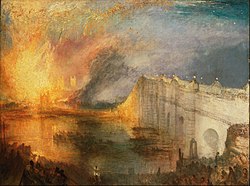
On 16 October 1834, a fire broke out in the Palace after an overheated stove used to destroy the Exchequer's stockpile of tally sticks set fire to the House of Lords Chamber. In the resulting conflagration both Houses of Parliament were destroyed, along with most of the other buildings in the palace complex. Westminster Hall was saved thanks to fire-fighting efforts and a change in the direction of the wind. The Jewel Tower, the Undercroft Chapel and the Cloisters and Chapter House of St Stephen's were the only other parts of the Palace to survive.[5]
Immediately after the fire, King William IV offered the almost-completed Buckingham Palace to Parliament, hoping to dispose of a residence he disliked. The building was considered unsuitable for parliamentary use, however, and the gift was rejected. Proposals to move to Charing Cross or St James's Park had a similar fate; the allure of tradition and the historical and political associations of Westminster proved too strong for relocation, despite the deficiencies of that site. In the meantime, the immediate priority was to provide accommodation for the next Parliament, and so the Painted Chamber and White Chamber were hastily repaired for temporary use by the Houses of Lords and Commons respectively, under the direction of the only remaining architect of the Office of Works, Sir Robert Smirke. Works proceeded quickly and the chambers were ready for use by February 1835.
In his speech opening Parliament in 1835, the King assured the members that the fire was accidental, and left it to Parliament itself to make "plans for [its] permanent accommodation."[6] Each house created a committee[7][8] and a public debate over the proposed styles ensued. The neo-Classical]] approach, adopted by the United States of America (used in the White House and the Federal Capitol in Washington), was popular at the time and had already been used by Soane in his additions to the old palace, but had connotations of revolution and republicanism, whereas Gothic design embodied conservative values. The committee in the House of Lords announced in June 1835 that "the style of the buildings should be either Gothic or Elizabethan".[9] On 14 July 1835 a Royal Commission was appointed, which accepted the recommendation of a competition, and architects began submitting proposals following some basic criteria.
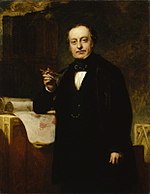
In February 1836, after studying 97 proposals, the Commission chose Charles Barry's plan for a Gothic-style palace, awarding him a prize (or "premium") of £1,500. The Architectural Magazine summarised Barry's winning plan as "a quadrangular pile, with the principal front facing the Thames, and a tower in the centre, 170ft high".[10] Barry's design was robustly Gothic but built upon the neo-classical principle of symmetry. Augustus Pugin was instrumental in helping Barry win the Commission, and his contribution can be seen in the Gothic detail, the vanes and spires. Pugin also contributed greatly to the distinctive Gothic interiors, including wallpapers, carvings, stained glass, floor tiles, metalwork and furniture.[11]
The foundation stone was laid in 1840;[12] the Lords Chamber was completed in 1847, and the Commons Chamber in 1852 (at which point Barry received a knighthood). Although most of the work had been carried out by 1860, construction was not finished until a decade afterwards.
Frescoes
With the building itself taking shape, it was time to think about its internal adornments.[13] In a process overseen by a Royal Fine Art Commission under the presidency of Prince Albert, a Select Committee which included Sir Robert Peel started to take witness accounts from experts in 1841. Those experts included Sir Martin Archer Shee, P.R.A., and Charles Lock Eastlake, painter and acknowledged authority on art history, soon to be first director of the National Gallery and de facto administrator of the whole Westminster decoration project. It was decided that the opportunity should be seized to encourage the development of a national British school of History Painting, and that the paintings should be done in fresco.
The call for artists to submit proposals resulted in a first exhibition in 1843 at Westminster Hall in which 140 cartoons were shown. Others followed but the progress was slow. Fresco proved to be a problematic technique for the English climate. The wall surfaces to be covered being vast, a number of paintings were in fact done in oil on canvas. With the death of Prince Albert in 1861 the scheme lost its driving force, but by then many paintings were completed or underway. William Dyce, who was the first to start fresco work in 1848, died in 1864, completing only five of seven commissioned works. The other major contributors were John Rogers Herbert, finishing in 1864 but having had some commissions cancelled, Charles West Cope who worked until 1869, Edward Matthew Ward until 1874, Edward Armitage, George Frederic Watts, John Callcott Horsley, John Tenniel and Daniel Maclise. In the 20th century, further paintings were commissioned from other artists.
Recent history
During the Second World War, the Palace of Westminster was hit by bombs on fourteen separate occasions. One bomb fell into Old Palace Yard on 26 September 1940 and severely damaged the south wall of St Stephen's Porch and the west front. The statue of Richard the Lionheart was lifted from its pedestal by the force of the blast, and its upheld sword bent, an image that was used as a symbol of the strength of democracy, "which would bend but not break under attack". Another bomb destroyed much of the Cloisters on 8 December.
[The worst raid took place in the night of 10/11 May 1941, when the Palace took at least twelve hits and three people (two policemen and the Resident Superintendent of the House of Lords, Edward Elliott were killed. An incendiary bomb hit the chamber of the House of Commons and set it on fire; another set the roof of Westminster Hall alight. The firefighters could not save both, and a decision was taken to try to rescue the Hall, In which they were successful; the abandoned Commons Chamber, on the other hand, was destroyed, as was the Members' Lobby. A bomb also struck the Lords Chamber, but went through the floor without exploding. The clock tower took a hit by a small bomb or anti-aircraft shell at the eaves of the roof, suffering much damage there. All the glass on the south dial was blown out, but the hands and bells were not affected, and the Great Clock continued to keep time accurately. The Commons sat in the Lords' chamber until their own was restored after the war, work lasting until 1950.[14]
The Palace of Westminster has decayed extensively over its many years. A 2012 report set out several options, including the possibility of parliament moving to other premises while work is carried out.[15]
Exterior
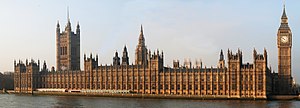 |
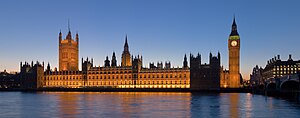 |
Sir Charles Barry's collaborative design for the Palace of Westminster uses the Perpendicular Gothic style, which was popular during the 15th century and returned during the Gothic revival of the 19th century. Barry was a classical architect, but he was aided by the Gothic architect Augustus Pugin. Westminster Hall, which was built in the 11th century and survived the fire of 1834, was incorporated in Barry's design. Pugin was displeased with the result of the work, especially with the symmetrical layout designed by Barry; he famously remarked, "All Grecian, sir; Tudor details on a classic body".[16]
Towers
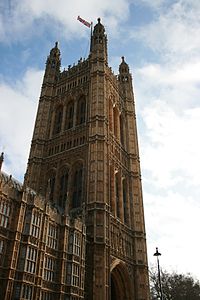
The Palace of Westminster features three main towers:
- The Victoria Tower
- The Elizabeth Tower, containing the Great Clock
- The Central Tower
The Victoria Tower is the tallest tower of the palace, standing at 323 feet[17] at the south-western corner of the Palace. It was an integral part of Barry's original design, conceived as the keep of a legislative "castle" (echoing his selection of the portcullis as his identifying mark in the planning competition), and used it as the royal entrance to the Palace and as a fireproof repository for the archives of Parliament.[18] Victoria Tower was re-designed several times, and its height increased progressively;[19] upon its completion in 1858, it was the tallest secular building in the world.[20]
At the base of the tower is the Sovereign's Entrance, used by the monarch whenever entering the Palace to open Parliament or for other state occasions. The 50 ft high archway is richly decorated with sculptures, including statues of Saints George, Andrew and Patrick, as well as of Queen Victoria herself.[21] The main body of Victoria Tower houses the three million documents of the Parliamentary Archives in over five miles of steel shelves spread over 12 floors; these include the master copies of all Acts of Parliament since 1497, and important manuscripts such as the original Bill of Rights of 1689 and the death warrant King Charles I.[22] At the top of the cast-iron pyramidal roof is a 22 m (73 ft)[17] flagstaff, from which flies the Royal Standard (the monarch's personal flag) when the Sovereign is present in the Palace. On all other days the Union Flag flies from the mast.[23]
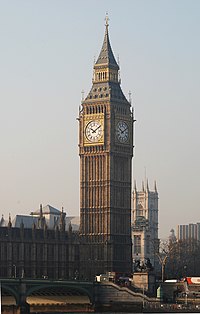
The Elizabeth Tower is the most famous of the towers. It houses the Great Clock and is commonly known as 'Big Ben' which technically is the name of the great bell in the tower which tolls the hour. It was known as "the Clock Tower" untl 2012, when it was renamed to honour the Diamond Jubilee of Queen Elizabeth II. At 316 feet, the Elizabeth Tower it is only slightly shorter than Victoria Tower but much slimmer.[17] It houses the Great Clock of Westminster, built by Edward John Dent on designs by amateur horologist Edmund Beckett Denison.[24] Striking the hour to within a second of the time, the Great Clock achieved standards of accuracy considered impossible by 19th-century clockmakers, and it has remained consistently reliable since it entered service in 1859.[25] The time is shown on four dials 23 ft in diameter, which are made of milk glass and are lit from behind at night; the hour hand is nine feet long and the minute hand 14 feet.[26] The Clock Tower was designed by Augustus Pugin and built after his death. Charles Barry asked Pugin to design the clock tower because Pugin had previously helped Barry design the Palace[27] In the 2012 BBC Four documentary, Richard Taylor gives a description of Pugin's Clock Tower: "It rises up from the ground in this stately rhythm, higher and higher, before you reach the clock face, picked out as a giant rose, its petals fringed with gold. Mediæval windows above that and then it hits the grey slate roof, its greyness relieved by those delicate little windows again picked out in gold leaf. And then rises up again in a great jet of gold to the higher roof that curves gracefully upwards to a spire with a crown and flowers and a cross. It's elegant and grand and has fairy tale qualities."
Five bells hang in the belfry above the clock. The four quarter bells strike the 'Westminster Chimes' (copied from those of King's College Chapel in Cambridge) every quarter-hour.[28] The largest bell strikes the hours; officially called The Great Bell of Westminster, it is generally referred to as Big Ben, a nickname of uncertain origins which, over time, has been colloquially applied to the whole tower. The first bell to bear this name cracked during testing and was recast;[29] the present bell later developed a crack of its own, which gives it a distinctive sound.[30] It is the third-heaviest bell in Britain, weighing 13.8 tonnes.[31][32] In the lantern at the top of Elizabeth Tower is the Ayrton Light, which is lit when either House of Parliament is sitting after dark. It was installed in 1885 at the request of Queen Victoria—so that she could see from Buckingham Palace whether the members were "at work"—and named after Acton Smee Ayrton, who was First Commissioner of Works in the 1870s.[33][34]
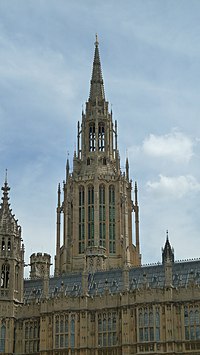
The Central Tower is the shortest of the Palace's three principal towers (at just under 300 ft)[17]). It is octagonal in form and stands over the middle of the building, immediately above the Central Lobby. It was added to the plans on the insistence of Dr David Boswell Reid, who was in charge of the ventilation of the new Houses of Parliament: his plan called for a great central chimney through which what he called "vitiated air" would be drawn out of the building with the heat and smoke of about four hundred fires around the Palace.[35] To accommodate the tower, Barry was forced to lower the lofty ceiling he had planned for the Central Lobby and reduce the height of its windows;[36] however, the tower itself proved to be an opportunity to improve the Palace's exterior design,[37] and Barry chose for it the form of a spire in order to balance the effect of the more massive lateral towers.[38] In the end, the Central Tower failed completely to fulfill its stated purpose, but it is notable as "the first occasion when mechanical services had a real influence on architectural design".[39]
Apart from the pinnacles which rise from between the window bays along the fronts of the Palace, numerous turrets enliven the building's skyline. Like the Central Tower, these have been added for practical reasons, and mask ventilation shafts.[37]
Grounds
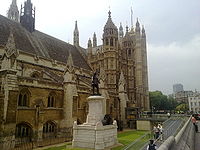
A number of small gardens surround the Palace of Westminster. The Victoria Tower Gardens are open as a public park along the side of the river south of the palace. Black Rod's Garden (named after the office of Gentleman Usher of the Black Rod) is closed to the public and is used as a private entrance. Old Palace Yard, in front of the Palace, is paved over and covered in concrete security blocks. Cromwell Green (also on the frontage, and in 2006 enclosed by hoardings for the construction of a new visitor centre), New Palace Yard (on the north side) and Speaker's Green (directly north of the Palace) are all private and closed to the public. College Green, opposite the House of Lords, is a small triangular green commonly used for television interviews with politicians.
Interior
The Palace of Westminster contains over 1,100 rooms, 100 staircases and three miles of passageways,[17] which are spread over four floors. The ground floor is occupied by offices, dining rooms and bars; the first floor (known as the principal floor) houses the main rooms of the Palace, including the debating chambers, the lobbies and the libraries. The top-two floors are used as committee rooms and offices.
Some of the interiors were designed and painted by J.G. Crace, working in collaboration with Pugin and others. For example, Crace decorated and gilded the ceiling of the Chapel of St. Mary Undercroft.[40]
Westminster Hall
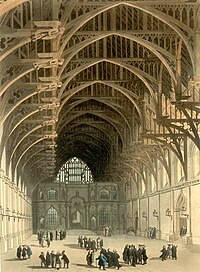
Westminster Hall, the oldest existing part of the Palace of Westminster, was erected in 1097, at which point it was the largest hall in Europe. The roof was probably originally supported by pillars, giving three aisles, but during the reign of King Richard II, this was replaced by a hammerbeam roof by the royal carpenter Hugh Herland, "the greatest creation of mediæval timber architecture", which allowed the original three aisles to be replaced with a single huge open space, with a dais at the end. The new roof was commissioned in 1393.[41] Richard's architect Henry Yevele left the original dimensions, refacing the walls, with fifteen life-size statues of kings placed in niches.[42] The rebuilding had been begun by King Henry III in 1245, but had by Richard's time been dormant for over a century. In Westminster Hall, the favourite heraldic badge of Richard II, a white hart, chained, and in an attitude of rest, is repeated as many as eighty-three times, without any of them being an exact counterpart of another.[43]
Westminster Hall has the largest clearspan mediæval roof in England, measuring 68 feet by 240 feet.[17] Oak timbers for the roof came from royal woods in Hampshire and from parks in Hertfordshire and from that of William Crozier of Stoke D'Abernon, who supplied over 600 oaks in Surrey, among other sources; they were assembled near Farnham, Surrey.[44] Accounts record the large number of wagons and barges which delivered the jointed timbers to Westminster for assembly.[45]
Westminster Hall has served numerous functions. It was primarily used for judicial purposes, housing three of the most important courts in the land: the Court of King's Bench, the Court of Common Pleas and the Court of Chancery. In 1875, these courts were amalgamated into the High Court of Justice, which continued to meet in Westminster Hall until it moved to the Royal Courts of Justice in 1882.[46] In addition to regular courts, Westminster Hall also housed important trials, including impeachment trials and the state trials of King Charles I at the end of the Civil War, William Wallace, Thomas More, Cardinal John Fisher, Guy Fawkes, the Earl of Strafford, the rebel Scottish lords of the 1715 and 1745 uprisings, and Warren Hastings. The St Stephen's Porch end of the Hall displays under the stained glass windows the Parliamentary War Memorial listing on eight panels the names of Members and staff of both Houses Parliament and their sons killed serving in the First World War; the window itself commemorates members and staff of both Houses who died in the Second World War.
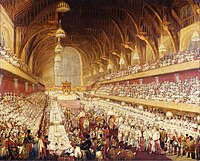
Westminster Hall has also served ceremonial functions. From the twelfth century to the nineteenth, coronation banquets honouring new monarchs were held here. The last coronation banquet was that of King George IV, held in 1821;[47] his successor, William IV, abandoned the idea because he deemed it too expensive. The Hall has been used for lyings-in-state during state and ceremonial funerals. Such an honour is usually reserved for the Sovereign and for their consorts; the only non-royals to receive it in the twentieth century were Frederick Sleigh Roberts, 1st Earl Roberts (1914) and Winston Churchill (1965). The most recent lying-in-state was that of Queen Elizabeth The Queen Mother in 2002.
It is considered a rare privilege for a foreign leader to be allowed to address both houses in Westminster Hall. Since the Second World War the only leaders to have done so have been French president Charles de Gaulle in 1960, South African president Nelson Mandela in 1996, Pope Benedict XVI in 2010, U.S. president Barack Obama in 2011 and Burmese opposition leader Aung San Suu Kyi in 2012.[48][49][50] President Obama was the first ever US President to be allowed to use the Hall for an address to Parliament[51] and Aung San Suu Kyi was the first non-head of state to be given the accolade of addressing MPs and peers in Westminster Hall.
Under reforms made in 1999, the House of Commons uses the Grand Committee Room next to Westminster Hall as an additional debating chamber. (Although it is not part of the main hall, the room is usually spoken of as such.) The seating is laid out in a U-shape, in contrast with the main Chamber, in which the benches are placed opposite each other. This pattern is meant to reflect the non-partisan nature of the debates held in Westminster Hall.
Outside links
| ("Wikimedia Commons" has material about Palace of Westminster) |
- Palace of Westminster
- National Heritage List 1226284: Palace of Westminster
- Westminster Hall – A Virtual Experience
- "A Victorian Novel in Stone" Rosemary Hill, The Wall Street Journal, 20 March 2009
References
- ↑ 426
- ↑ "A Brief Chronology of the House of Commons" (PDF). House of Commons Information Office. April 2009. http://www.parliament.uk/documents/commons-information-office/g03.pdf. Retrieved 5 August 2010.
- ↑ "All Change at the Palace of Westminster", BBC History
- ↑ Fraser, Antonia (1992). The Wives of Henry VIII. New York: Alfred A Knopf. ISBN 978-0394585383.
- ↑ "Architecture of the Palace: The Great Fire of 1834". UK Parliament. http://www.parliament.uk/about/living-heritage/building/palace/architecture/palacestructure/great-fire/. Retrieved 5 August 2010.
- ↑ Parliamentary Debates, House of Lords, 24 February 1835 , columns 63–64
- ↑ Parliamentary Debates, House of Commons, 2 March 1835 , columns 469–471
- ↑ Parliamentary Debates, House of Lords, 3 March 1835 , columns 489–490
- ↑ "House of Lords – New Houses of Parliament". Hansard. 15 June 1835. http://hansard.millbanksystems.com/lords/1835/jun/15/new-houses-of-parliament. Retrieved 18 April 2012.
- ↑ "Miscellaneous Notices respecting the Competition Designs for the New Houses of Parliament". Architectural Magazine 3: 104. 1836. https://books.google.co.uk/books?id=r4lAAAAAYAAJ&printsec=frontcover#v=snippet&q=a%20quadrangular%20pile&f=false. Retrieved 10 September 2011.
- ↑ Pugin: God's Own Architect - BBC Four
- ↑ Riding, Christine (7 February 2005). "Westminster: A New Palace for a New Age". BBC. http://www.bbc.co.uk/history/trail/church_state/westminster_later/westminster_new_palace_02.shtml. Retrieved 27 December 2009.
- ↑ The complex history surrounding the decoration is best summarized by T. S. R. Boase, The Decorations of the New Palace of Westminster 1841–1863, in: Journal of the Warburg and Courtauld Institutes 17:1954, pp. 319–358.
- ↑ "'The House' Returns," British Pathé newsreel 50/87, issue date 30 October 1950. Accessed 4 January 2014.
- ↑ "Parliament is falling down. So what can be done about it?", The Guardian, 3 March 2015
- ↑ Devey, Peter (February 2001). "Commons Sense". The Architectural Review. http://findarticles.com/p/articles/mi_m3575/is_1248_209/ai_72302588/. Retrieved 3 December 2009.
- ↑ 17.0 17.1 17.2 17.3 17.4 17.5 The Palace of Westminster - House of Commons Information Office
- ↑ Quinault (1991), p. 81; Jones (1983), p. 113.
- ↑ Port (1976), pp. 76, 109; Riding and Riding (2000), p. 116.
- ↑ Quinault (1991), p. 81.
- ↑ #Fell|Fell and Mackenzie (1994), p. 30.
- ↑ Fell and Mackenzie (1994), p. 44.
- ↑ "Early Day Motions – EDM 1199: Union Flag at Parliament". UK Parliament. 29 March 2010. http://edmi.parliament.uk/EDMi/EDMDetails.aspx?EDMID=40851. Retrieved 20 February 2010.
- ↑ "Building the Great Clock". UK Parliament. http://www.parliament.uk/about/living-heritage/building/palace/big-ben/building-clock-tower/building-great-clock. Retrieved 14 May 2010.
- ↑ Macdonald (2004), pp. xiii–xiv.
- ↑ "Great Clock facts". UK Parliament. http://www.parliament.uk/about/living-heritage/building/palace/big-ben/facts-figures/great-clock-facts. Retrieved 14 May 2010.
- ↑ BBC Four Pugin: God's Own Architect presented by Richard Taylor 2012
- ↑ Fell and Mackenzie (1994), pp. 24, 26.
- ↑ "The Great Bell – Big Ben". UK Parliament. http://www.parliament.uk/about/living-heritage/building/palace/big-ben/building-clock-tower/great-bell. Retrieved 14 May 2010.
- ↑ Macdonald (2004), pp. xvi–xvii, 50.
- ↑ "The Great Bell and the quarter bells". UK Parliament. http://www.parliament.uk/about/living-heritage/building/palace/big-ben/facts-figures/great-bell. Retrieved 14 May 2010.
- ↑ Macdonald (2004), p. 174.
- ↑ Jones (1983), pp. 112–3.
- ↑ "Elizabeth Tower virtual tour". UK Parliament. http://www.parliament.uk/visiting/online-tours/virtualtours/bigben-tour. Retrieved 15 May 2010.
- ↑ Port (1976), p. 221; Jones (1983), p. 119.
- ↑ Jones (1983), pp. 108–109; Field (2002), p. 189.
- ↑ 37.0 37.1 Riding and Riding (2000), p. 120.
- ↑ Port (1976), p. 103.
- ↑ Collins, Peter (1965). Changing Ideals in Modern Architecture 1750–1950 (1st ed.). Montreal, Quebec; Kingston, Ontario: McGill-Queen's University Press. p. 238. ISBN 978-0773500488. cited in Port (1976), p. 206.
- ↑ Art in Parliament: Houses of Parliament, St Stephen's Crypt (Restored).
- ↑ "The hammer-beam roof". UK Parliament. http://www.parliament.uk/about/living-heritage/building/palace/westminsterhall/architecture/the-hammer-beam-roof-/. Retrieved 28 May 2011.
- ↑ Jonathan Alexander & Paul Binski (eds), Age of Chivalry, Art in Plantagenet England, 1200–1400, pp. 506–507, Royal Academy/Weidenfeld & Nicholson, London 1987. Only six of the statues, rather damaged, remain, and the dias has been remodelled, but otherwise the hall remains largely as Richard and his architect Henry Yevele left it.
- ↑ Charles Boutell, The Handbook to English Heraldry 11th ed., rev. A. C. Fox-Davies (London: Reeves & Turner, 1914), p. 28
- ↑ Gerhold (1999), pp. 19–20.
- ↑ Salzman, L. F. (1992) [1952]. Building in England down to 1540: A Documentary History. Oxford University Press, USA. ISBN 978-0198171584. OCLC 758400852.
- ↑ "Royal Courts of Justice visitors guide". Her Majesty's Courts Service. Archived from the original on 24 July 2011. http://web.archive.org/web/20100724214206/http://www.hmcourts-service.gov.uk/infoabout/rcj/history.htm. Retrieved 16 May 2010.
- ↑ "Westminster Hall: Coronation Banquets". UK Parliament. http://www.parliament.uk/about/living-heritage/building/palace/westminsterhall/other-uses/coronation-banquets/. Retrieved 5 August 2010.
- ↑ "Queen to roll out red carpet for Obamas". AFP (via Yahoo News). 22 May 2011. Archived from the original on 24 May 2011. https://web.archive.org/20110524065211/http://news.yahoo.com:80/s/afp/20110522/wl_uk_afp/usobamadiplomacybritainroyals_20110522145524. Retrieved 25 May 2011.
- ↑ "US President Barack Obama addressing MPs and peers". BBC News. 22 May 2011. Archived from the original on 25 May 2011. http://www.webcitation.org/5ywktyOBN. Retrieved 25 May 2011.
- ↑ "Aung San Suu Kyi calls for UK's support over Burma". BBC News. 21 June 2012. http://www.bbc.co.uk/news/uk-18529727. Retrieved 24 June 2012.
- ↑ "President Obama: Now is time for US and West to lead". BBC News. 22 May 2011. http://www.bbc.co.uk/news/uk-politics-13533306. Retrieved 25 May 2011.
Books
- Cooke, Sir Robert (1987). The Palace of Westminster. London: Burton Skira. ISBN 978-0333459232.
- Fell, Sir Bryan H.; Mackenzie, K. R. (1994) [1930]. Natzler, D. L. ed. The Houses of Parliament: A Guide to the Palace of Westminster (15th ed.). London: Her Majesty's Stationery Office. ISBN 978-0117015791.
- Field, John (2002). The Story of Parliament in the Palace of Westminster. London: Politico's Publishing; James & James Publishers. ISBN 978-1904022145.
- Gerhold, Dorian (1999). Westminster Hall: Nine Hundred Years of History. London: James & James Publishers. ISBN 978-0907383888.
- Guide to the Palace of Westminster. London: Warrington. 1911. OCLC 5081639.
- Jones, Christopher (1983). The Great Palace: The Story of Parliament. London: British Broadcasting Corporation. ISBN 978-0563201786.
- Macdonald, Peter (2004). Big Ben: The Bell, the Clock and the Tower. Stroud: Sutton Publishing. ISBN 978-0750938280.
- Port, M. H., ed (1976). The Houses of Parliament. New Haven, Connecticut; London: Yale University Press. ISBN 978-0300020229.
- Quinault, Roland (1992). "Westminster and the Victorian Constitution". Transactions of the Royal Historical Society. 6 2: 79–104. doi:10.2307/3679100. (subscription required)
- Riding, Christine; Riding, Jacqueline, eds (2000). The Houses of Parliament: History, Art, Architecture. London: Merrell Publishers. ISBN 978-1858941127.
- Tanfield, Jennifer (1991). In Parliament 1939–50: The Effect of the War on the Palace of Westminster. London: Her Majesty's Stationery Office. ISBN 978-0108506406. OCLC 26808272.
- Wilson, Robert (2005) [1994]. The Houses of Parliament. Norwich: Jarrold Publishing. ISBN 978-1841650999.
- Shenton, Caroline (2012). The Day Parliament Burned Down. Oxford: Oxford University Press. ISBN 978-0199646708. OCLC 785869543.
| World Heritage Sites in the United Kingdom |
|---|
|
Bath • Blaenavon Industrial Landscape • Blenheim Palace • Canterbury Cathedral, St Augustine's Abbey & St. Martin's Church • Castles and Town Walls of King Edward I • Cornwall and West Devon Mining Landscape • Derwent Valley Mills • Durham Castle & Cathedral • Edinburgh Old Town & New Town • Forth Bridge • Frontiers of the Roman Empire: Antonine Wall & Hadrian's Wall • Giant's Causeway • Ironbridge Gorge • Jurassic Coast • Kew Gardens • Liverpool Maritime Mercantile City • Maritime Greenwich • New Lanark • Heart of Neolithic Orkney • Pontcysyllte Aqueduct • St Kilda • Saltaire • Stonehenge, Avebury & Associated Sites • Studley Royal Park & Fountains Abbey • Tower of London • Palace of Westminster, Westminster Abbey & St Margaret's Church |
